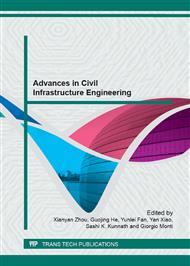p.313
p.319
p.325
p.329
p.334
p.341
p.346
p.350
p.354
Study on Bond Properties of Textile Reinforced Concrete
Abstract:
Textile reinforced concrete (TRC) allows the light weight structures and offers a high effectiveness of the reinforcement by using continuous yarns. The study on the bond behavior between textile and concrete matrix is significant for the development of computational methods that analyze the textile reinforced concrete. The paper analyzes the bonding constitutive model of TRC and the bonding mechanism that the stress is transferred from fine concrete to textile, pointing out quadruple linear model can accurately reflect the bond behavior between fiber and concrete, illustrates the main influences on bond between the fine grained matrix and fabrics based on the pull-out test, the result reveals that with initial bond length increasing, the maximum pull force increases, and increasing concrete strength and improving workability of concrete matrix, epoxy resin impregnating and sand covering of textile as well as prestressing textile can increase the bond strength between textile and concrete. Finally the paper proposes that epoxy resin impregnating and 0.15 ~ 0.30mm sand covering of textile can be used as a practical method of improving bond properties in the engineering.
Info:
Periodical:
Pages:
334-340
Citation:
Online since:
January 2013
Authors:
Keywords:
Price:
Сopyright:
© 2013 Trans Tech Publications Ltd. All Rights Reserved
Share:
Citation:


